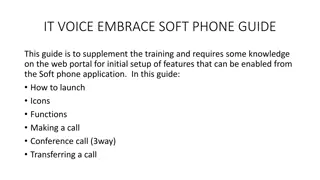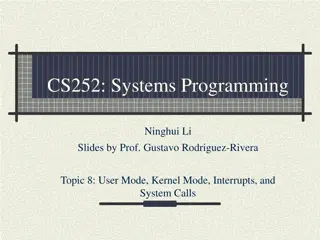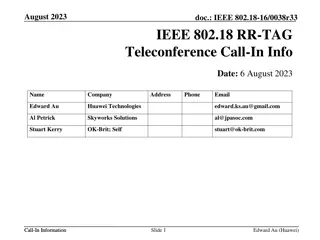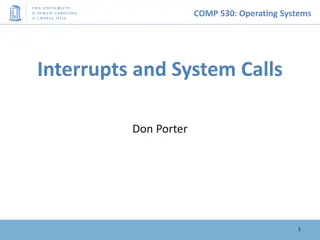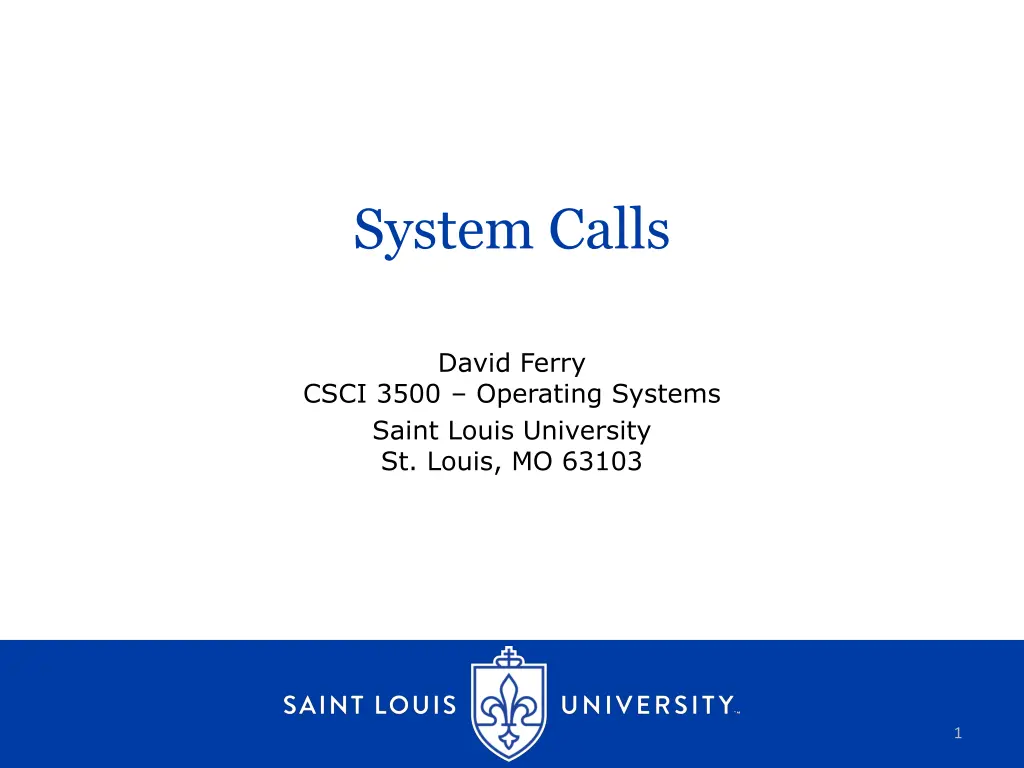
Understanding System Calls and Memory Allocation in Operating Systems
Explore the concept of system calls, their implementation, and where code fragments reside in memory within an operating system environment. See examples and understand the interaction between user space, kernel space, and the operating system.
Download Presentation

Please find below an Image/Link to download the presentation.
The content on the website is provided AS IS for your information and personal use only. It may not be sold, licensed, or shared on other websites without obtaining consent from the author. If you encounter any issues during the download, it is possible that the publisher has removed the file from their server.
You are allowed to download the files provided on this website for personal or commercial use, subject to the condition that they are used lawfully. All files are the property of their respective owners.
The content on the website is provided AS IS for your information and personal use only. It may not be sold, licensed, or shared on other websites without obtaining consent from the author.
E N D
Presentation Transcript
System Calls David Ferry CSCI 3500 Operating Systems Saint Louis University St. Louis, MO 63103 1
System call? As opposed to what? Consider example program: int max( int a, int b ){ if ( a > b ) return a; else return b; } int main( int argc, char* argv[] ){ int z = max( 5, 10 ); char buffer[ bufferSize ]; int bytes = snprintf( buffer, bufferSize, Max is %d , z ); write( STDOUT_FILENO, buffer, bytes); }
System call? As opposed to what? Consider example program: int max( int a, int b ){ if ( a > b ) return a; else return b; } Implemented by our program. int main( int argc, char* argv[] ){ int z = max( 5, 10 ); char buffer[ bufferSize ]; int bytes = snprintf( buffer, bufferSize, Max is %d , z ); write( STDOUT_FILENO, buffer, bytes); }
System call? As opposed to what? Consider example program: int max( int a, int b ){ if ( a > b ) return a; else return b; } Implemented by our program. int main( int argc, char* argv[] ){ int z = max( 5, 10 ); char buffer[ bufferSize ]; int bytes = snprintf( buffer, bufferSize, Max is %d , z ); write( STDOUT_FILENO, buffer, bytes); } Implemented by C standard library.
System call? As opposed to what? Consider example program: int max( int a, int b ){ if ( a > b ) return a; else return b; } Implemented by our program. int main( int argc, char* argv[] ){ int z = max( 5, 10 ); char buffer[ bufferSize ]; int bytes = snprintf( buffer, bufferSize, Max is %d , z ); write( STDOUT_FILENO, buffer, bytes); } Implemented by the operating system Needs OS cooperation to work AKA System call call to the operating system Implemented by C standard library.
Where does each code fragment reside? Imagine the entire memory of a machine: 0xFFFF Operating System Kernel Space User Space 0x0
Where does each code fragment reside? Imagine the entire memory of a machine: 0xFFFF Operating System Kernel Space User Space Program Program Program 0x0
Where does each code fragment reside? Imagine the entire memory of a machine: 0xFFFF Operating System Kernel Space User Space Program Program Library Program 0x0
Where does each code fragment reside? Imagine the entire memory of a machine: 0xFFFF .stack Local scope (stack) variables Operating System Kernel Space User Space Dynamically Allocated memory (malloc) Program .heap Program Global scope (static) variables .data Library Program .text User code 0x0
Single-program function calls 1. Code executing at some place in .text section Execution jumps to another place in .text Eventually jumps back .stack Operating System 2. Kernel Space 3. User Space Program .heap Program .data Library 2 Program .text 1
Library function calls 1. Code executing at some place in .text section Execution jumps to .text section of a library residing in userspace Eventually jumps back 2. .stack Operating System Kernel Space 3. Library User Space Program .heap Program 2 .data Library Program .text The library is said to be mapped into the program. 1
System calls 1. Code executing at some place in .text section Needs to execute code somewhere in operating system, crossing the kernelspace boundary 2. .stack Operating System Kernel Space ? User Space Program .heap Program .data Library Program 1 .text
System calls 1. Code executing at some place in .text section Needs to execute code somewhere in operating system, crossing the kernelspace boundary 2. .stack Operating System Kernel Space User Space Program Difficulties: 1) We can t give user programs access to OS memory like we can to system libraries 2) Need to protect system and other users from unauthorized access .heap Program .data Library Program .text
Being Careful About Access to OS What bad things can happen if a user program can read, write, or execute in the OS memory? The OS enforces access control (e.g. file read/write/delete, event permissions) The OS stores and authenticates secrets (e.g. password authentication) Allowing unprivileged access circumvents OS security and policies. Question: How does a user program achieve OS tasks without getting access to the OS?
System Call Mechanism 1. User program requests OS services 2. User program stops executing, hands execution over to OS 3. OS determines whether request is valid and allowable for user 4. OS performs service, if valid 5. OS returns a status code to user program 6. OS stops executing, hands execution back to user program *Main point: OS code determines when/how to run.
Low Level Implementation Low level mechanisms are finicky, for example, recall how a single function call is implemented in assembly. int z = max( 5, 10 ) Making a function call at the low level 1. Arguments stored in registers or on stack (depends on what ISA you re using) 2. Unconditional jump to function code 3. Update stack and base pointers 4. Execute function code 5. Store return value in known place 6. Unconditional jump back to calling code 7. Restore stack
32-bit x86 ISA Function Call In x86: pushl $10 pushl $5 int z = max( 5, 10 ) Making a function in x86 1. Arguments stored on stack 2. Unconditional jump to function code 3. Update stack and base pointers 4. Execute function code 5. Store return value in known place 6. Unconditional jump back to calling code 7. Restore stack
32-bit x86 ISA Function Call In x86: pushl $10 pushl $5 call max int z = max( 5, 10 ) Making a function in x86 1. Arguments stored on stack 2. Unconditional jump to function code 3. Update stack and base pointers 4. Execute function code 5. Store return value in known place 6. Unconditional jump back to calling code 7. Restore stack
32-bit x86 ISA Function Call In x86: pushl $10 pushl $5 call max pushl %ebp movl %esp, %ebp int z = max( 5, 10 ) Making a function in x86 1. Arguments stored on stack 2. Unconditional jump to function code 3. Update stack and base pointers 4. Execute function code 5. Store return value in known place 6. Unconditional jump back to calling code 7. Restore stack
32-bit x86 ISA Function Call In x86: pushl $10 pushl $5 call max pushl %ebp movl %esp, %ebp <function code executes> int z = max( 5, 10 ) Making a function in x86 1. Arguments stored on stack 2. Unconditional jump to function code 3. Update stack and base pointers 4. Execute function code 5. Store return value in known place 6. Unconditional jump back to calling code 7. Restore stack
32-bit x86 ISA Function Call In x86: pushl $10 pushl $5 call max pushl %ebp movl %esp, %ebp <function code executes> <move return val to eax> int z = max( 5, 10 ) Making a function in x86 1. Arguments stored on stack 2. Unconditional jump to function code 3. Update stack and base pointers 4. Execute function code 5. Store return value in known place 6. Unconditional jump back to calling code 7. Restore stack
32-bit x86 ISA Function Call In x86: pushl $10 pushl $5 call max pushl %ebp movl %esp, %ebp <function code executes> <move return val to eax> popl %ebp return popl %edx popl %edx int z = max( 5, 10 ) Making a function in x86 1. Arguments stored on stack 2. Unconditional jump to function code 3. Update stack and base pointers 4. Execute function code 5. Store return value in known place 6. Unconditional jump back to calling code 7. Restore stack
Implementing System Call Mechanism Particulars vary by OS convention, processor instruction set architecture, and over time. 1. User program requests OS services 2. User program stops executing, hands execution over to OS 3. OS determines whether request is valid and allowable for user 4. OS performs service, if valid 5. OS returns a status code to user program 6. OS stops executing, hands execution back to user program
Implementing System Call Mechanism Particulars vary by OS convention, processor instruction set architecture, and over time. 1. User program requests OS service Need to specify what service and with what arguments, e.g. open() needs to know what file to open and with what permissions Done by placing a specific system call number in processor register, and arguments in other registers E.g. on Linux see man 2 syscall to see architecture calling conventions listed explicitly, see man 2 syscalls to see a comprehensive list of system calls
Implementing System Call Mechanism Particulars vary by OS convention, processor instruction set architecture, and over time. 2. User program stops executing, hands execution over to OS Executes a special assembly instruction to initiate the system call, see man 2 syscall for details. Called lots of different things but software interrupt and trap are common Stops execution of user program, and transfers execution to a specific known starting point in operating system 3. OS determines whether request is valid and allowable for user OS checks what service is requested by looking at processor registers, and the OS determines if the user program is allowed to do what it wants to do
Implementing System Call Mechanism Particulars vary by OS convention, processor instruction set architecture, and over time. 4. OS performs service, if valid OS is in total control at this point, executing OS code only. This only happens if the OS system call entry point has determined that the actions are valid. 5. OS returns a status code to user program Loads a single integer value in a specific register 6. OS stops executing, hands execution back to user program Execution resumes in user program
System calls 1. Code executing at some place in .text section Code requests system call OS executes service on user program s behalf OS returns control to user program 2. 3. .stack Operating System 3 4. Kernel Space User Space Program .heap Program .data 4 Library 2 Program .text 1



